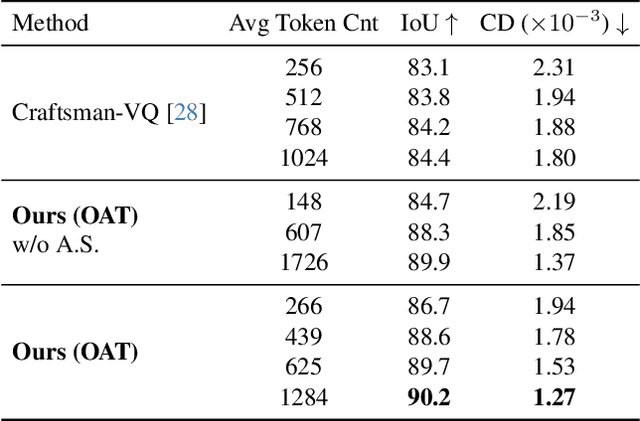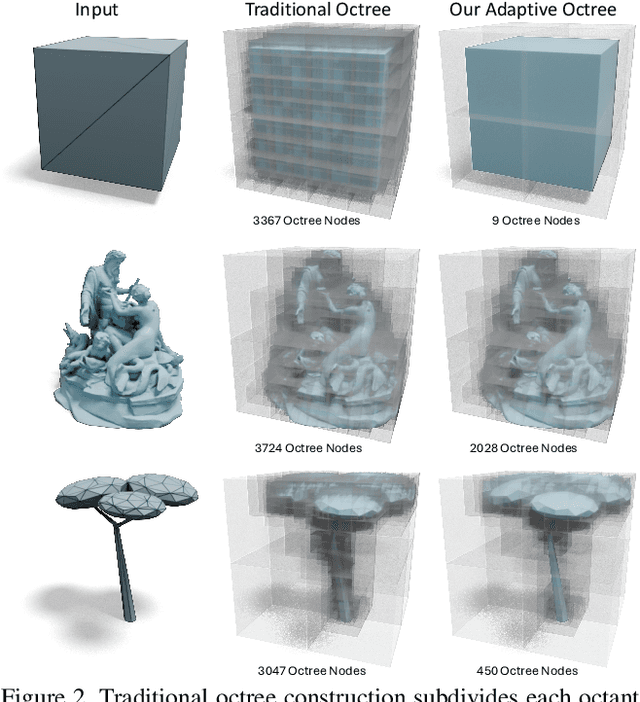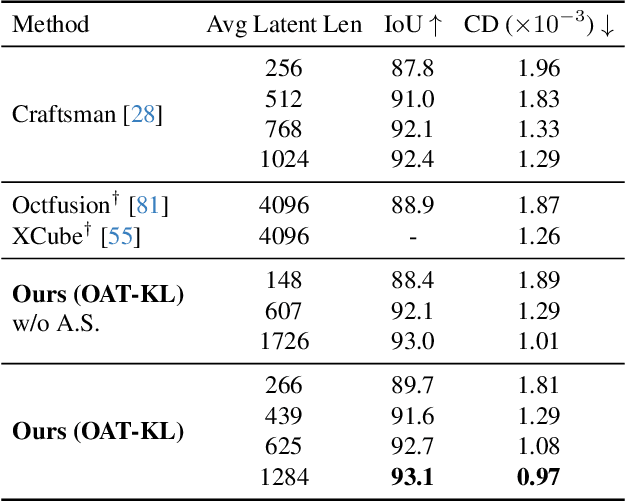Maneesh Agrawala
Taming Flow-based I2V Models for Creative Video Editing
Sep 26, 2025Abstract:Although image editing techniques have advanced significantly, video editing, which aims to manipulate videos according to user intent, remains an emerging challenge. Most existing image-conditioned video editing methods either require inversion with model-specific design or need extensive optimization, limiting their capability of leveraging up-to-date image-to-video (I2V) models to transfer the editing capability of image editing models to the video domain. To this end, we propose IF-V2V, an Inversion-Free method that can adapt off-the-shelf flow-matching-based I2V models for video editing without significant computational overhead. To circumvent inversion, we devise Vector Field Rectification with Sample Deviation to incorporate information from the source video into the denoising process by introducing a deviation term into the denoising vector field. To further ensure consistency with the source video in a model-agnostic way, we introduce Structure-and-Motion-Preserving Initialization to generate motion-aware temporally correlated noise with structural information embedded. We also present a Deviation Caching mechanism to minimize the additional computational cost for denoising vector rectification without significantly impacting editing quality. Evaluations demonstrate that our method achieves superior editing quality and consistency over existing approaches, offering a lightweight plug-and-play solution to realize visual creativity.
Mixture of Contexts for Long Video Generation
Aug 28, 2025Abstract:Long video generation is fundamentally a long context memory problem: models must retain and retrieve salient events across a long range without collapsing or drifting. However, scaling diffusion transformers to generate long-context videos is fundamentally limited by the quadratic cost of self-attention, which makes memory and computation intractable and difficult to optimize for long sequences. We recast long-context video generation as an internal information retrieval task and propose a simple, learnable sparse attention routing module, Mixture of Contexts (MoC), as an effective long-term memory retrieval engine. In MoC, each query dynamically selects a few informative chunks plus mandatory anchors (caption, local windows) to attend to, with causal routing that prevents loop closures. As we scale the data and gradually sparsify the routing, the model allocates compute to salient history, preserving identities, actions, and scenes over minutes of content. Efficiency follows as a byproduct of retrieval (near-linear scaling), which enables practical training and synthesis, and the emergence of memory and consistency at the scale of minutes.
Captain Cinema: Towards Short Movie Generation
Jul 24, 2025Abstract:We present Captain Cinema, a generation framework for short movie generation. Given a detailed textual description of a movie storyline, our approach firstly generates a sequence of keyframes that outline the entire narrative, which ensures long-range coherence in both the storyline and visual appearance (e.g., scenes and characters). We refer to this step as top-down keyframe planning. These keyframes then serve as conditioning signals for a video synthesis model, which supports long context learning, to produce the spatio-temporal dynamics between them. This step is referred to as bottom-up video synthesis. To support stable and efficient generation of multi-scene long narrative cinematic works, we introduce an interleaved training strategy for Multimodal Diffusion Transformers (MM-DiT), specifically adapted for long-context video data. Our model is trained on a specially curated cinematic dataset consisting of interleaved data pairs. Our experiments demonstrate that Captain Cinema performs favorably in the automated creation of visually coherent and narrative consistent short movies in high quality and efficiency. Project page: https://thecinema.ai
Radial Attention: $O(n\log n)$ Sparse Attention with Energy Decay for Long Video Generation
Jun 24, 2025Abstract:Recent advances in diffusion models have enabled high-quality video generation, but the additional temporal dimension significantly increases computational costs, making training and inference on long videos prohibitively expensive. In this paper, we identify a phenomenon we term Spatiotemporal Energy Decay in video diffusion models: post-softmax attention scores diminish as spatial and temporal distance between tokens increase, akin to the physical decay of signal or waves over space and time in nature. Motivated by this, we propose Radial Attention, a scalable sparse attention mechanism with $O(n \log n)$ complexity that translates energy decay into exponentially decaying compute density, which is significantly more efficient than standard $O(n^2)$ dense attention and more expressive than linear attention. Specifically, Radial Attention employs a simple, static attention mask where each token attends to spatially nearby tokens, with the attention window size shrinking with temporal distance. Moreover, it allows pre-trained video diffusion models to extend their generation length with efficient LoRA-based fine-tuning. Extensive experiments show that Radial Attention maintains video quality across Wan2.1-14B, HunyuanVideo, and Mochi 1, achieving up to a 1.9$\times$ speedup over the original dense attention. With minimal tuning, it enables video generation up to 4$\times$ longer while reducing training costs by up to 4.4$\times$ compared to direct fine-tuning and accelerating inference by up to 3.7$\times$ compared to dense attention inference.
Uncovering Conceptual Blindspots in Generative Image Models Using Sparse Autoencoders
Jun 24, 2025Abstract:Despite their impressive performance, generative image models trained on large-scale datasets frequently fail to produce images with seemingly simple concepts -- e.g., human hands or objects appearing in groups of four -- that are reasonably expected to appear in the training data. These failure modes have largely been documented anecdotally, leaving open the question of whether they reflect idiosyncratic anomalies or more structural limitations of these models. To address this, we introduce a systematic approach for identifying and characterizing "conceptual blindspots" -- concepts present in the training data but absent or misrepresented in a model's generations. Our method leverages sparse autoencoders (SAEs) to extract interpretable concept embeddings, enabling a quantitative comparison of concept prevalence between real and generated images. We train an archetypal SAE (RA-SAE) on DINOv2 features with 32,000 concepts -- the largest such SAE to date -- enabling fine-grained analysis of conceptual disparities. Applied to four popular generative models (Stable Diffusion 1.5/2.1, PixArt, and Kandinsky), our approach reveals specific suppressed blindspots (e.g., bird feeders, DVD discs, and whitespaces on documents) and exaggerated blindspots (e.g., wood background texture and palm trees). At the individual datapoint level, we further isolate memorization artifacts -- instances where models reproduce highly specific visual templates seen during training. Overall, we propose a theoretically grounded framework for systematically identifying conceptual blindspots in generative models by assessing their conceptual fidelity with respect to the underlying data-generating process.
Packing Input Frame Context in Next-Frame Prediction Models for Video Generation
Apr 21, 2025Abstract:We present a neural network structure, FramePack, to train next-frame (or next-frame-section) prediction models for video generation. The FramePack compresses input frames to make the transformer context length a fixed number regardless of the video length. As a result, we are able to process a large number of frames using video diffusion with computation bottleneck similar to image diffusion. This also makes the training video batch sizes significantly higher (batch sizes become comparable to image diffusion training). We also propose an anti-drifting sampling method that generates frames in inverted temporal order with early-established endpoints to avoid exposure bias (error accumulation over iterations). Finally, we show that existing video diffusion models can be finetuned with FramePack, and their visual quality may be improved because the next-frame prediction supports more balanced diffusion schedulers with less extreme flow shift timesteps.
Efficient Autoregressive Shape Generation via Octree-Based Adaptive Tokenization
Apr 03, 2025



Abstract:Many 3D generative models rely on variational autoencoders (VAEs) to learn compact shape representations. However, existing methods encode all shapes into a fixed-size token, disregarding the inherent variations in scale and complexity across 3D data. This leads to inefficient latent representations that can compromise downstream generation. We address this challenge by introducing Octree-based Adaptive Tokenization, a novel framework that adjusts the dimension of latent representations according to shape complexity. Our approach constructs an adaptive octree structure guided by a quadric-error-based subdivision criterion and allocates a shape latent vector to each octree cell using a query-based transformer. Building upon this tokenization, we develop an octree-based autoregressive generative model that effectively leverages these variable-sized representations in shape generation. Extensive experiments demonstrate that our approach reduces token counts by 50% compared to fixed-size methods while maintaining comparable visual quality. When using a similar token length, our method produces significantly higher-quality shapes. When incorporated with our downstream generative model, our method creates more detailed and diverse 3D content than existing approaches.
Cube: A Roblox View of 3D Intelligence
Mar 19, 2025Abstract:Foundation models trained on vast amounts of data have demonstrated remarkable reasoning and generation capabilities in the domains of text, images, audio and video. Our goal at Roblox is to build such a foundation model for 3D intelligence, a model that can support developers in producing all aspects of a Roblox experience, from generating 3D objects and scenes to rigging characters for animation to producing programmatic scripts describing object behaviors. We discuss three key design requirements for such a 3D foundation model and then present our first step towards building such a model. We expect that 3D geometric shapes will be a core data type and describe our solution for 3D shape tokenizer. We show how our tokenization scheme can be used in applications for text-to-shape generation, shape-to-text generation and text-to-scene generation. We demonstrate how these applications can collaborate with existing large language models (LLMs) to perform scene analysis and reasoning. We conclude with a discussion outlining our path to building a fully unified foundation model for 3D intelligence.
MoVer: Motion Verification for Motion Graphics Animations
Feb 19, 2025



Abstract:While large vision-language models can generate motion graphics animations from text prompts, they regularly fail to include all of spatio-temporal properties described in the prompt. We introduce MoVer, a motion verification DSL based on first-order logic that can check spatio-temporal properties of a motion graphics animation. We identify a general set of such properties that people commonly use to describe animations (e.g., the direction and timing of motions, the relative positioning of objects, etc.). We implement these properties as predicates in MoVer and provide an execution engine that can apply a MoVer program to any input SVG-based motion graphics animation. We then demonstrate how MoVer can be used in an LLM-based synthesis and verification pipeline for iteratively refining motion graphics animations. Given a text prompt, our pipeline synthesizes a motion graphics animation and a corresponding MoVer program. Executing the verification program on the animation yields a report of the predicates that failed and the report can be automatically fed back to LLM to iteratively correct the animation. To evaluate our pipeline, we build a synthetic dataset of 5600 text prompts paired with ground truth MoVer verification programs. We find that while our LLM-based pipeline is able to automatically generate a correct motion graphics animation for 58.8% of the test prompts without any iteration, this number raises to 93.6% with up to 50 correction iterations. Project website: https://mover-dsl.github.io/
Instance Segmentation of Scene Sketches Using Natural Image Priors
Feb 13, 2025Abstract:Sketch segmentation involves grouping pixels within a sketch that belong to the same object or instance. It serves as a valuable tool for sketch editing tasks, such as moving, scaling, or removing specific components. While image segmentation models have demonstrated remarkable capabilities in recent years, sketches present unique challenges for these models due to their sparse nature and wide variation in styles. We introduce SketchSeg, a method for instance segmentation of raster scene sketches. Our approach adapts state-of-the-art image segmentation and object detection models to the sketch domain by employing class-agnostic fine-tuning and refining segmentation masks using depth cues. Furthermore, our method organizes sketches into sorted layers, where occluded instances are inpainted, enabling advanced sketch editing applications. As existing datasets in this domain lack variation in sketch styles, we construct a synthetic scene sketch segmentation dataset featuring sketches with diverse brush strokes and varying levels of detail. We use this dataset to demonstrate the robustness of our approach and will release it to promote further research in the field. Project webpage: https://sketchseg.github.io/sketch-seg/
 Add to Chrome
Add to Chrome Add to Firefox
Add to Firefox Add to Edge
Add to Edge